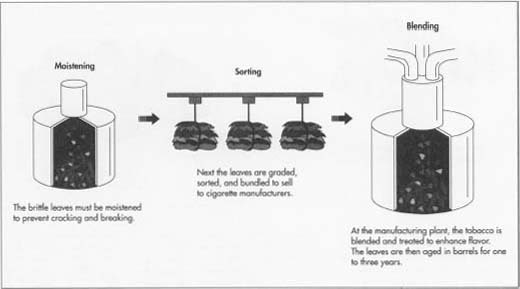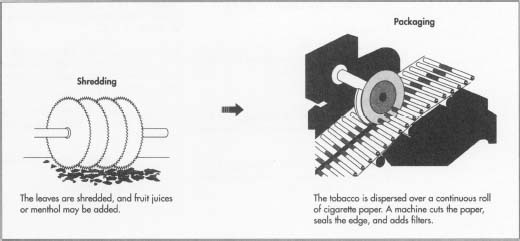The Cigarette Manufacturing Process
Growing the tobacco
- 1 Tobacco is initially grown in outdoor frames called seedbeds. In warm regions, the frames are covered with mulch or a cotton top sheet; in cooler regions, glass or plastic shields are installed to protect the plants. After 8-10 weeks, when the seedlings are almost 10 inches (25 cm) tall, they are transplanted to the fields. Although transplanting machines are available, the vast majority of the world's tobacco plants are still planted manually. As the plants grow, the heads are broken off by hand so the leaves will grow fuller, a process called topping. The plants stay in the field 90-120 days before they are harvested.
Harvesting the tobacco
- 2 Tobacco plants are harvested by one of two methods, priming or stalk-cutting. In the priming method, the leaves are gathered and brought to a curing bam as they ripen. In the stalk-cutting method, the entire plant is cut and the plants are allowed to
wilt in the field before being taken to the curing barn.

Curing the leaf
- 3 Next, the leaves are carefully, gradually dried in a specially constructed barn by air curing, flue curing, or fire curing. Air curing uses natural weather conditions to dry tobacco. Stalks are hung in a barn with ventilators that can be opened and closed to control temperature and humidity. Artificial heat is used only during cold or excessively humid weather. The stalks are hung for four to eight weeks.
- 4 Flue curing is done in small, tightly constructed barns that are artificially heated. The heat comes from flues (metal pipes) that are attached to furnaces. Open oil and gas burners are sometimes used, but this method is problematic because smoke can-not come in direct contact with the tobacco. Flue curing takes about four to six days.
- 5 Fire curing dries tobacco with low-burning wood fires whose smoke comes in direct contact with the leaves, thus producing a smoky flavor and aroma. The tobacco is allowed to dry naturally in the barn for three to five days before it is fire-dried for 3-40 days.
Moistening and stripping
- 6 Unless humid weather conditions eliminate the need, the brittle, cured tobacco leaves must be conditioned in moistening chambers so they do not break when they are handled. After moistening, the tobacco is stripped. During this process, the leaves are sprayed with additional moisture as a precaution against cracking or breaking.
Sorting and auctioning
- 7 After the leaves are moistened and stripped, they are sorted into grades based on size, color, and quality, and tied in bundles for shipment. The farmers then bring the tobacco to warehouses, where it is placed in baskets, weighed, graded once again by a government inspector and, finally, auctioned to cigarette manufacturers.
Conditioning, aging, and blending
- 8 After they have purchased and transported the material to their factories, manufacturers treat and age the tobacco to enhance its flavor. First, the manufacturer
redries the tobacco. This involves completely drying the leaves by air and then adding a uniform amount of moisture. Packed into barrels called hogsheads, the tobacco is then aged for one to three years, during which period it develops its flavor and aroma. After it is aged, the tobacco leaves are again moistened and the stalks and other wastes removed. Leaves from different types of tobacco are mixed to create a particular flavor.

Making the cigarettes
- 9 After blending, the tobacco leaves are pressed into cakes and mechanically shredded. Materials such as fruit juices or menthol are added to give additional flavor. The final shredded tobacco is then dispersed over a continuous roll of cigarette paper. A machine rolls the shredded tobacco into the paper and cuts it to the desired length. A device then grabs each cigarette and fastens a filter in one end. Modern cigarette machines can produce 25-30 cigarettes a second.
Packaging
- 10 The final stage of cigarette manufacture is packaging. The completed cigarettes are packed 20 to a package. The hard or soft packs are mechanically sealed in cellophane and hand-placed in cartons